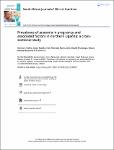| dc.contributor.author | Udho, Samson | |
| dc.contributor.author | Nankumbi, Joyce | |
| dc.contributor.author | Namutebi, Mariam | |
| dc.contributor.author | Mukunya, David | |
| dc.contributor.author | Ndeezi, Grace | |
| dc.contributor.author | Tumwine, James K | |
| dc.date.accessioned | 2022-11-29T07:31:35Z | |
| dc.date.available | 2022-11-29T07:31:35Z | |
| dc.date.issued | 2022 | |
| dc.identifier.citation | Samson Udho, Joyce Nankumbi, Mariam Namutebi, David Mukunya, Grace Ndeezi & James K Tumwine (2022): Prevalence of anaemia in pregnancy and associated factors in northern Uganda: a cross-sectional study, South African Journal of Clinical Nutrition, DOI: 10.1080/16070658.2022.2148909 | en_US |
| dc.identifier.uri | https://doi.org/10.1080/16070658.2022.2148909 | |
| dc.identifier.uri | http://ir.lirauni.ac.ug/xmlui/handle/123456789/449 | |
| dc.description.abstract | Background: Anaemia in pregnancy is associated with poor maternal and foetal outcomes. Nonetheless, there is a paucity of
recent literature on the predictors of anaemia during pregnancy in the context of northern Uganda, a region emerging out of
decades of war. A study was undertaken to determine the prevalence and factors associated with anaemia among pregnant
women in northern Uganda.
Methods: In this cross-sectional study, 320 pregnant women seeking care at Lira Regional Referral Hospital were consecutively
enrolled. Data were collected using a structured interviewer-administered questionnaire. Data collected included:
demographic, obstetric, nutritional and dietary characteristics of study participants. Data analysis consisted of descriptive
statistics, cross-tabulations and logistic regression with 95% confidence and a p-value of < 0.05 as significant using STATA
version 14.
Results: The mean age of the women was 25.3 ± 5.6 years while their mean gestational age was 25.4 ± 7.8 weeks. The overall
prevalence of anaemia (Hb < 11 g/dl in the first and third trimesters and less than 10.5 g/dl in the second trimester) was 24.7%.
Iron deficiency was prevalent in half of the women (50%) with anaemia. Factors independently associated with anaemia
included taking antimalarial prophylaxis (AOR 0.44; 95% CI 0.19, 0.99) and consumption of legumes and cereals more than
twice in the previous week (AOR 0.46; 95% CI 0.24, 0.89).
Conclusion: One-quarter of pregnant women in this study population based in northern Uganda were anaemic. There is a need
to strengthen interventions to control anaemia during pregnancy, particularly the intake of antimalarial prophylaxis and
consumption of iron-rich locally available foods. | en_US |
| dc.language.iso | en | en_US |
| dc.publisher | South African Journal of Clinical Nutrition | en_US |
| dc.subject | anaemia | en_US |
| dc.subject | iron deficiency | en_US |
| dc.subject | pregnancy | en_US |
| dc.subject | Uganda | en_US |
| dc.title | Prevalence of anaemia in pregnancy and associated factors in northern Uganda: a crosssectional study | en_US |
| dc.type | Article | en_US |

